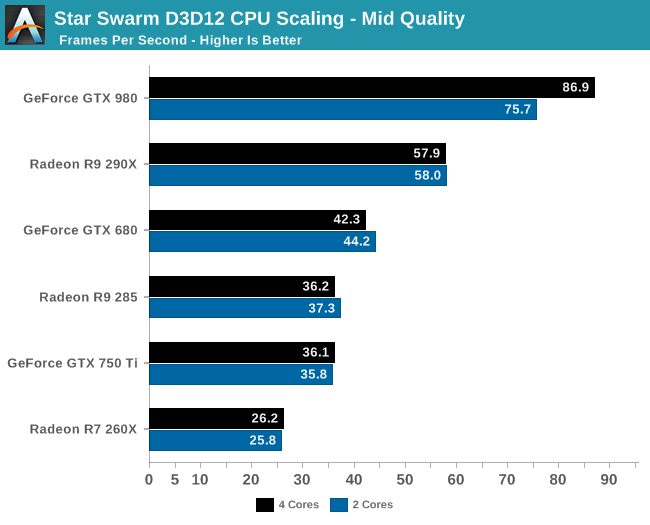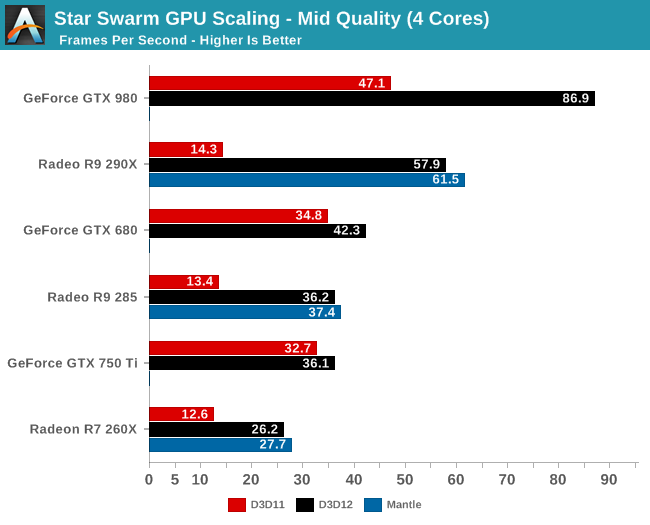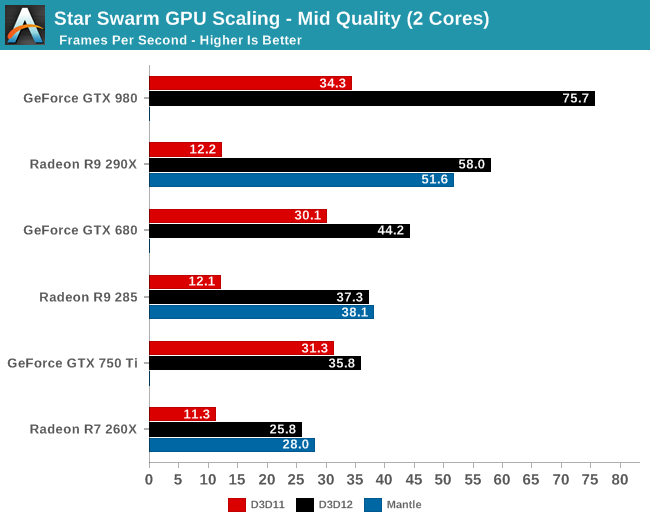The DirectX 12 Performance Preview: AMD, NVIDIA, & Star Swarm
by Ryan Smith on February 6, 2015 2:00 PM EST- Posted in
- GPUs
- AMD
- Microsoft
- NVIDIA
- DirectX 12
Mid Quality Performance
Since our evaluation so far has been focused on performance with Star Swarm’s most resource intensive Extreme setting, we wanted to shake things up by trying a lower quality setting.
In this case Star Swarm’s various quality levels adjust both the CPU and GPU workload, with the Mid quality setting reducing both the number of draw calls generated and the amount of work generated per frame for the GPU. As a result we’re not adjusting just the CPU or the GPU workload, but it can give us an idea of what to expect from DirectX 12 and Star Swarm at lower settings more suitable for weaker systems.

Even with this lower quality setting, the CPU results tell us that only the GTX 980 is truly CPU bottlenecked with 2 cores. Everything else from the 290X on down can reach its GPU limit with a relatively weak CPU.


Overall the numbers are different, but the lineup is the same whether it’s Extreme quality or Mid quality. Every vendor still sees massive gains from enabling DirectX 12, though the overall gains aren’t quite as great as with Extreme quality. Meanwhile GTX 750 Ti in particular continues to see the weakest gains from DirectX 12, at only 14% for a 2 core configuration, thanks to a combination of NVIDIA’s lower CPU consumption and earlier GPU bottleneck.










245 Comments
View All Comments
Mr Perfect - Sunday, February 8, 2015 - link
That's not what he's saying though, he said TDP is some measure of what amount of heat is 'wasted" heat. As if there's some way to figure out what part of the 165 watts is doing computational work, and what is just turning into heat without doing any computational work. That's not what TDP measures.Also, CPUs and GPUs can routinely go past TDP, so I'm not sure where people keep getting TDP is maximum power draw from. It's seen regularly in the benchmarks here at Anandtech. That's usually one of the goals of the power section of reviews, seeing if the manufacturers TDP calculation of typical power draw holds up in the real world.
Mr Perfect - Sunday, February 8, 2015 - link
Although, now that I think about it, I do remember a time when TDP actually was pretty close to maximum power draw. But then Intel came out with the Netburst architecture and started defining TDP as the typical power used by the part in real world use, since the maximum power draw was so ugly. After a lot of outrage from the other companies, they picked up the same practice so they wouldn't seem to be at a disadvantage in regard to power draw. That was ages ago though, TDP hasn't meant maximum power draw for years.Strunf - Sunday, February 8, 2015 - link
TDP essentially means your GPU can work at that power input for a long time, in the past the CPU/GPU were close to it cause they didn't have throttle, idles and what not technologies. Today they have and they can go past the TDP for "short" period of times, with the help of thermal sensors they can adjust the power as they need without risking of burning down the CPU/GPU.YazX_ - Friday, February 6, 2015 - link
Dude, its total System power consumption not video card only.Morawka - Friday, February 6, 2015 - link
are you sure you not looking at factory overclocked cards? The 980 has a 8 pin and 6 pin connector. You gotta minus the CPU and Motherboard power.Check any reference review on power consumption
http://www.guru3d.com/articles_pages/nvidia_geforc...
Yojimbo - Friday, February 6, 2015 - link
Did you notice the 56% greater performance? The rest of the system is going to be drawing more power to keep up with the greater GPU performance. NVIDIA is getting much greater benefit of having 4 cores than 2, for instance. And who knows, maybe the GPU itself was able to run closer to full load. Also, the benchmark is not deterministic, as mentioned several times in the article. It is the wrong sort of benchmark to be using to compare two different GPUs in power consumption, unless the test is run significantly many times. Finally, you said the R9 290X-powered system consumed 14W more in the DX12 test than the GTX 980-powered system, but the list shows it consumed 24W more. Let's not even compare DX11 power consumption using this benchmark, since NVIDIA's performance is 222% higher.MrPete123 - Friday, February 6, 2015 - link
Win7 will be dominant in businesses for some time, but not gaming PCs where this will be benefit more.Yojimbo - Friday, February 6, 2015 - link
Most likely the main reasons for consumers not upgrading to Windows 10 will be laziness, comfort, and ignorance.Murloc - Saturday, February 7, 2015 - link
people who are CPU bottlenecked are not that kind of people given the amount of money they spend on GPUs.Frenetic Pony - Friday, February 6, 2015 - link
FREE. Ok. FREE. F and then R and then E and then another E.